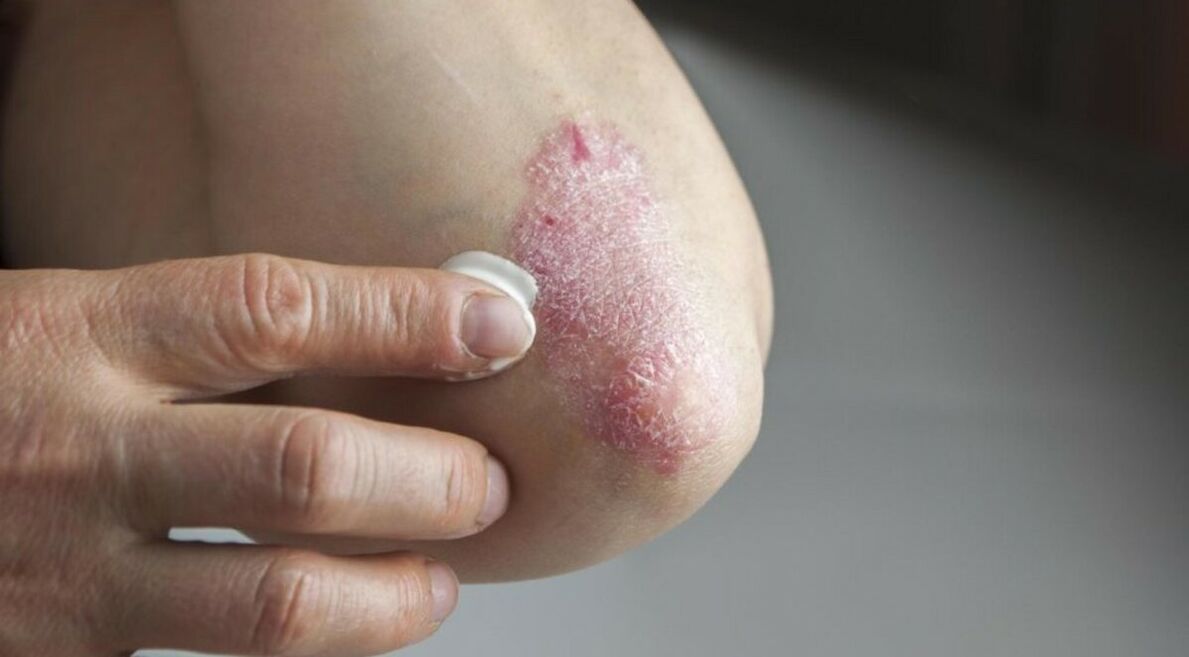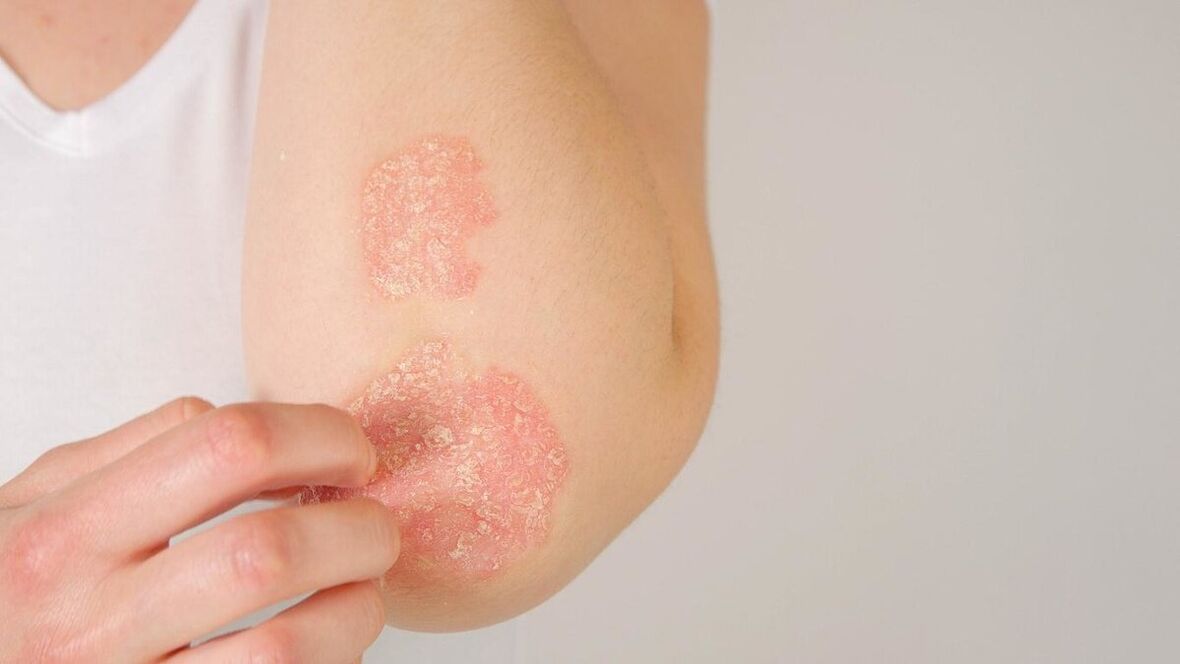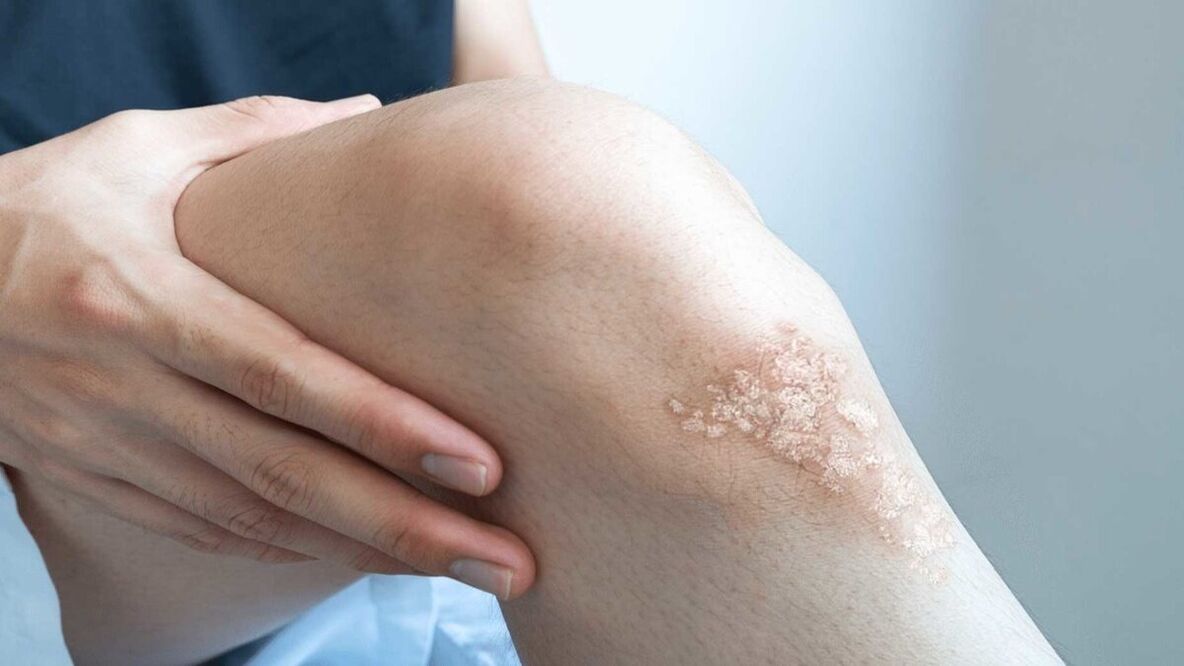
Psoriasis is a dermatological disease characterized by red spots with silvery scales on the skin.
Depending on the type of psoriasis, it affects the knees, elbows, trunk, nails, face or scalp.
What is Psoriasis?
Psoriasis is an autoimmune disease that causes skin cells to grow too quickly, forming red patches that accumulate and become inflamed. Symptoms of psoriasis can vary depending on its type, stage, and cause. Common symptoms of psoriasis:
- inflammatory areas of the skin;
- whitish-silver scales or plates on red spots;
- pain and burning of the skin;
- dry, cracked skin (itching and bleeding may occur);
- stiff and swollen joints;
- thickened, ribbed nails.
Psoriasis in children usually affects the scalp and nails first, then spreads to the elbows, knees, and trunk. With nail psoriasis in children, depending on the type of psoriasis, thick nails with no pits or small ridges, as well as yellowing or separation of the nail bed may be observed.
If you notice the first signs of psoriasis, you should consult a doctor. A dermatologist deals with the diagnosis and treatment of psoriasis in adults. If red spots or silver scales appear on the skin in children, you should consult a pediatrician.
How does psoriasis start?
Psoriasis begins with the formation of small red blisters that rise a few millimeters above the skin (looks like a regular rash). As the size increases, white or silver coins may appear. The scales on top may fall off. The remaining scales stick together and start to hurt and itch. When scratching the resulting rash, the scales can come off the skin and cause bleeding.
What does psoriasis look like?
With psoriasis, red spots appear on light skin, and brown or purple spots on dark skin. In the initial stage of scalp psoriasis, the spots look like dandruff (because of the white scales). Forms of psoriasis:
- mild form of psoriasis (less than three percent of the body is affected, rashes are localized on the scalp or extremities);
- moderate form of psoriasis (rash covers three to ten percent of the body, affecting the scalp, arms, legs and trunk);
- severe form of psoriasis (more than ten percent of the body is affected, rashes appear on the palms, feet and face).
Treatment of psoriasis is selected by a dermatologist depending on the form and type of psoriasis, symptoms and location of the rash. If the treatment is not carried out correctly or on time, large areas of lesions appear on the skin.
Where can psoriasis occur?
The localization of psoriasis spots depends on its type. Types of Psoriasis:
- plaque (vulgar) psoriasis. Plaque psoriasis causes dry, raised patches of skin covered with silvery scales. Psoriasis appears on the elbows, knees, back, and scalp;
- erythrodermic psoriasis. The skin looks burnt, tremors appear, the temperature rises;
- guttate psoriasis. Small, scaly, flesh-colored spots resembling water droplets appear on the arms, legs, and trunk;
- pustular psoriasis. With pustular psoriasis, white blisters filled with pus and large inflamed areas of the skin form on the skin. Localized in small areas of the skin, affecting the legs or arms;
- exudative psoriasis. Spots covered with yellow crusts appear on the skin;
- reverse psoriasis. Smooth red spots appear on the skin. The rash appears in the folds of the skin (armpits, buttocks, genitals).
In nail psoriasis, the skin collects under the nails, causing them to lift and form indentations ("pits"). The skin under the nail plate is white, yellow or brown. Nails become rough, brittle and break easily.
Dermatologists also distinguish palmoplantar psoriasis. Skin with psoriasis on the palms and soles is dry and prone to cracking.
Psoriasis of the eyelid causes redness, flaking and crusting around the eyelids. Other symptoms of psoriasis on the eyelids:
- the formation of scales that peel off and stick to the eyelashes;
- pain when moving the eyes;
- irritation of the skin of the eyelids, accompanied by pain and itching.
The edges of the eyelids can turn up or down depending on the location of the spots, which causes the eyeball to rub against the eyelashes. Possible consequences of eyelid psoriasis include uveitis (inflammation of the eyes) and vision loss.
Psoriasis can appear on the eyebrows, behind and around the ears, and in the ear canal. Sometimes psoriasis affects the oral cavity, causing redness and burning of the lips, gums, tongue and cheeks. Oral psoriasis can make it difficult to chew and swallow food.
Manifestations of psoriasis depend on its type, symptoms and stage. Psoriasis can be seen in the photo.



Causes of the development of psoriasis
Psoriasis is caused by a malfunction of the immune system in which white blood cells mistakenly start attacking skin cells. Due to the activity of leukocytes, the process of formation of new skin cells decreases from a month to a few days. Prematurely formed cells are pushed by the body to the surface of the skin, where they accumulate and become spots or plaques.
A genetic predisposition (family history of psoriasis) or triggers (environmental factors that increase the risk of psoriasis) can cause the immune system to malfunction. Factors leading to the development of psoriasis:
- infections (tonsillitis, herpes, lichen);
- skin trauma (sunburn, insect bites, scratches, cuts);
- smoking or alcohol abuse;
- uncontrolled use of drugs;
- regular stressful situations (stress leads to the development of psoriasis);
- weather (dry and cold conditions);
- abrupt discontinuation of systemic or oral corticosteroids.
These factors can lead to the development or exacerbation of psoriasis in people who are prone to it. Psoriasis can be prevented by identifying and eliminating factors that cause exacerbations.
Exacerbation of psoriasis
Psoriasis on the face, limbs and head is characterized by periods of exacerbation (symptoms appear intensively) and periods of remission (the rash decreases in size, the pain disappears). Remission periods last from one month to one year. Stages of psoriasis:
- progressive stage(beginning of psoriasis). Small nodular rashes accompanied by itching appear on the skin. Areas of redness increase, forming plaques;
- stationary phase. New nodules (papules) do not appear, after the formation of scales or crusts on the plaques, the inflammation subsides;
- regressive stage. Plaques are reduced, itching and peeling disappear.
A dermatologist will help eliminate the exacerbation of psoriasis, he will identify triggers and prescribe treatment. Following your doctor's advice will help reduce periods of flare-ups and increase periods of remission.
How to treat psoriasis?
Before starting treatment for psoriasis, a dermatologist takes a history (asking about symptoms, when they appeared, and whether there is a family history of psoriasis) and a visual examination of the rash. After making a diagnosis, the doctor chooses a comprehensive treatment for psoriasis. Treatment for psoriasis includes:
- ointments, shampoos, creams and gels based on extracts of algae and Dead Sea minerals;
- phototherapy (by exposing the skin affected by the rash to ultraviolet rays, the growth of skin cells decreases, leading to the normalization of the condition).
For psoriasis, a dermatologist recommends taking vitamins. Your doctor will prescribe vitamins A, D, E, K, B, and C to help produce healthy skin cells and reduce inflammation and symptoms.
Diet for psoriasis
For psoriasis, a dermatologist recommends dietary changes. Foods that reduce inflammation:
- oily fish (tuna, salmon);
- flax and pumpkin seeds;
- nuts (walnuts, almonds);
- cabbage, spinach.
Following a diet for psoriasis helps reduce symptoms and prevent the development of complications (high blood pressure, diabetes, heart disease). If you have psoriasis on your legs, arms, or face, you should limit your alcohol intake.
Your diet should also include the consumption of foods containing fatty acids (sardines, salmon, shrimp, flaxseed). It is recommended to minimize the consumption of foods containing saturated fats (fatty meat, confectionery) and simple carbohydrates (dairy products, grapes, bakery products).
Prevention of psoriasis
Preventive measures will help prevent the development and progression of psoriasis on the arms, legs and head. Prevention of psoriasis includes:
- dietary changes (rejection of alcohol, simple carbohydrates and saturated fats, consumption of foods with fatty acids);
- protecting your head and body from the sun (using sunscreen and a hat);
- to give up smoking;
- reducing the risk of skin damage (use of insect repellent sprays, gloves, long sleeves);
- moisturizes the skin (dry skin is prone to damage).
Extreme temperatures should be avoided to reduce the likelihood of psoriasis flare-ups. Exposure to very cold or very hot temperatures can dry out or damage the skin. Minimizing stressful situations will help prevent the appearance of psoriasis due to nervousness.
How to distinguish psoriasis from dermatitis?
Psoriasis of the scalp (seborrheic psoriasis) is similar to seborrheic dermatitis. Dermatitis can be distinguished from scalp psoriasis with the help of a dermatologist. Symptoms of seborrheic dermatitis:
- redness of the skin with the formation of oily white or yellow scales (when pressed, sebum - sebum - can be released);
- dandruff (skin flakes) that accumulate near the hair shaft.
You can distinguish psoriasis from dermatitis by the location of the rash. Unlike seborrheic dermatitis, psoriasis does not only occur on the head, but also spreads beyond the scalp and appears on other parts of the body (limbs, back, nails). With psoriasis, the areas of the skin affected by the rash should be painful and itchy, and with dermatitis, you may experience mild itching on the scalp.
Popular questions
- Is psoriasis contagious?
Psoriasis is not contagious. Contact with a person with psoriasis (communication, kissing, sex), touching the affected areas of the skin will not cause the appearance of rashes, because it is not an infectious disease, but an autoimmune one.
- How to wash your hair with psoriasis?
For psoriasis, you can wash your hair with a shampoo based on Dead Sea minerals and algae extract. Independent selection of shampoos and the use of folk remedies (chamomile tincture, celandine, aloe vera, apple cider vinegar) will be ineffective and may lead to worsening of symptoms. If a skin rash is detected, you should contact a dermatologist who will choose the treatment option that suits you after examining and diagnosing the redness.
- How to distinguish nail psoriasis from fungus?
You can distinguish nail psoriasis from fungus using the symptoms. With psoriasis, the nails thicken, fall off, break easily, and the skin underneath turns yellow, white or brown. Indentations (pits), ridges, or holes may develop in the nails.
The fungus causes gray, brown, or green spots on the nails that darken and increase in size over several weeks. Fungal nail infection does not cause pitting, but it can cause the nails to become thin or thick.
- What can't you eat if you have psoriasis?
If you have psoriasis, you should avoid foods that increase inflammation (dairy, red meat, fatty foods, refined sugar, citrus fruits, tomatoes, potatoes). Eggs, liver, soybeans and energy drinks should be avoided. These products contain choline and taurine, which can cause psoriasis flare-ups.
- What can psoriasis be confused with?
Psoriasis can be confused with eczema, ringworm, lichen planus or lichen planus. A dermatologist will help distinguish psoriasis from other dermatological diseases by taking a history, visual examination and diagnostic tests.























